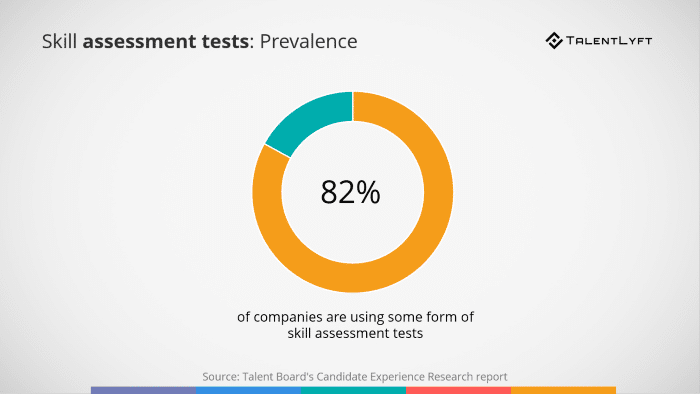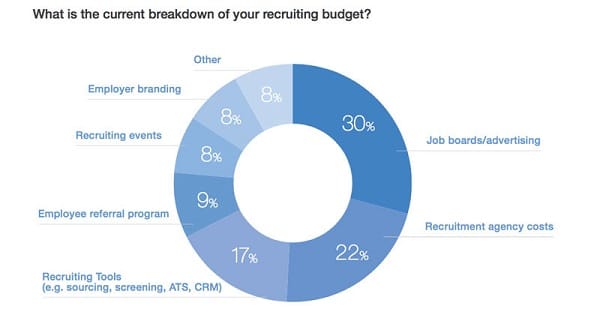A business recruitment strategy is a plan created for the purpose of recruiting the best-suited employees for the company. It should be detailing the positions, timescales, and explain why and how it will be conducted.
The recruitment process is an integral part of any business. A recent study revealed that 52% of US workers were considering a job change while 44% had actual plans in place.
Having a strong recruitment strategy increases your chances of getting the best workers while reducing the time spent on the hiring process and bringing down the costs.
Your strategy must be clear, realistic, and easy to communicate. There has to be room for some tweaks though, as the staffing situation often changes in every company.
Good employees play a significant role in achieving goals and company success. If you want a successful business you should learn how to attract, hire, and retain the best team within your budget.
Here’s everything you need to know about creating a business recruitment strategy:
1. Identify what your company needs
Identifying your company’s needs is the first step to building your business recruitment strategy. Think about what skills the company is missing that your current employees don’t fill. 82% of companies are using some sort of skill assessment test. You can perform them on the job candidates as well as your current employees. If your company doesn’t already do it, it should do one once a year.
Perhaps your employees’ workload is making them overdoing it and adding new staff would be beneficial? Is your company growing or taking on more clients and your employees simply have no time to fit in more work?
The task is simpler when someone decides to leave the company. The position opens up and your manager should be able to discuss with you the department’s needs.
Crafting a fine recruitment strategy will also help to see the future company hiring needs clearer. When working on the plan, you have to analyze the company’s growth and think about new job functions, promotions, and employee turnover. Think about the departments that are expected to grow. Perhaps there will be a need for new positions within those departments? Should new projects have more people on board?
Once you’ve learned which skills your company is lacking, you can have a look at your current employees. It’s very often that employees’ skills are not fully utilized by the company.
You may be able to fill in a new position with your current employee. If your current team doesn’t have the skills needed for a vacancy though, you’ll have to source the candidates from external sources.
2. Make a recruitment calendar
A recruitment calendar should show the start points and the deadlines of the processes of filling the positions. It should cover the whole year. Now you’ve learned how many new hires every department needs, you should reflect that in the recruitment calendar.
Here’s an example of a simple recruitment calendar created in a spreadsheet:
Using a calendar for your business recruitment strategy will let you prepare for the recruitment process and plan ahead to avoid missing deadlines. Most companies use digital calendars these days. Using a tool that is synced with your Google or Outlook email account, like Yello, will help you schedule interviews and assessments.
This way everyone involved in the recruitment process will have access to the calendar. It will make the scheduling process easier, especially when it comes to the interview process.
Crafting a digital recruitment calendar is the first step to modernizing the recruitment process. If you aren’t already using your digital channels for this purpose, now it’s a good time to start. Every company should have a hiring calendar and use it when deciding on the yearly budget, to make sure there are resources for hiring processes.
3. Create a hiring process
Finding the best candidates takes time and effort. Now you have your recruitment calendar, you‘ll be able to fill the positions just in time. A good business recruitment strategy should also detail the hiring process that fits the company’s expectations and budget.
Before posting the job offer, decide if you’ll be hiring someone from the organization or a new employee. If you decide to offer the position to someone from the company, you will need to add the position they will be vacating to your recruitment calendar.
Depending on the position you will be looking to fill, the usual hiring process consists of the following steps:
- Job post
- Resume screening
- Screening call
- Assessment test (if needed)
- Interview
- Background & reference checks
- Decision and job offer
Once you have decided on your hiring process steps, each of them needs to be detailed in your plan:
- Job post – Where will you be posting job offers? Will you be using social media? Will you be using paid advertising? Will you be attending job fairs?
- Resume screening – Which candidates can you reject at this stage? Will you be looking for graduates or interns?
- Screening call – Detail what information about the company you will be sharing with the candidates and what kind of questions you will be asking.
- Assessment test – This point depends on the position that you are trying to fill. If you’re looking for a writer, for example, you might want to include a writing test in the hiring process.
- Interview – Who will be attending the interview? It makes sense for the department’s manager to take part, as well as an HR personnel.
- Background & reference checks – You can have your HR department perform the checks or hire an external company to do it. Make a decision and put it into your plan.
- Decision and job offer – Who will choose the right candidate? How will you let the candidate know? Any negotiations regarding salary or terms of employment should take the stage at this point. Who will be performing them?
The next step is to decide what tools you will be using for the hiring process steps. A video platform is an example of such a tool if you’ll be interviewing online.
Some companies use mailbox extensions to create an email sequence to automatically follow up with candidates that don’t reply to their first email. Others use applicant tracking software (ATS) for application reviews.
Now that you’ve got your hiring process detailed, you can start the next step.
4. Write the job descriptions
The next point in creating a business recruitment strategy is writing the job descriptions.
List all the responsibilities assigned to the job and the skills and qualifications required. These should be aligned with what you’ve determined are your company’s hiring needs.
Many candidates can be discouraged from seeing a long list of required skills. Instead, try to divide the skills in the job description into two groups: required and nice to have. When you include skills that are more or less optional in the “required skills” section, you risk losing good candidates that may be discouraged from applying because they lack one or two skills that aren’t very crucial in the first place.
Also, think about the certificates or degrees that the candidates need to hold. Some jobs require college degrees, while others require specific skills that your candidates can develop through work-related experience. These so-called “new collar” jobs require industry certifications that non-degree holders can earn through experience and training courses.
Here’s a good example of a job description of a graphic designer posted on Jooble:
Apart from the job title, the location, job specifications, and responsibilities it also lists the salary range. Further on you can read about the requirements including skills needed (technical skills as well as soft skills):
It comes as no surprise that the two top pieces of information researched by job seekers are the company’s salaries and benefits.
Apart from the salary range and staff perks, an attractive job description should include the post’s location and information if the position is remote, especially now that workers are starting to explore jobs that allow them to work from home.
5. Create a recruiting budget
A recruiting budget is a comprehensive annual estimate of the total cost of hiring at a company. To create your recruiting budget, you need to go back to your hiring process and the tools you specified. It should include expenses including internal expenses, like recruiters’ salaries, and external ones, such as advertising expenses, agency fees, or the software that you will be using.
A recruiting budget should also have room for unplanned expenses, such as employee attrition. It has to align with your business’s annual business strategies. If the company plans to expand some departments, the hiring budget needs to reflect it.
Here’s an example breakdown of a recruitment budget:
Finally, remember that as in any project, it’s best to come slightly under or on the budget in the end, and the hiring process is no exception. As much as you want to hire the best candidates possible, you will still have to balance it with your business’s operational needs.
In Closing
A good business recruitment strategy is critical to a business’s success because it makes the whole process clearer, quicker, and helps to achieve the goal, which is employing the best candidates for your company.
To sum up, in order to create an effective business recruitment strategy it’s critical to:
- Identify your company needs
- Make a recruitment calendar
- Create a hiring process
- Write the job descriptions
- Create a recruiting budget
Don’t be tempted to skip any of these points as they all relate to each other. For example, you won’t be able to decide on the budget if you don’t know your company’s needs in detail or the tools required for the hiring process.
Use the above points when you create your strategy but don’t forget to review your company’s recruitment strategy annually to make sure it fits the company’s needs and budget.













Leave A Comment